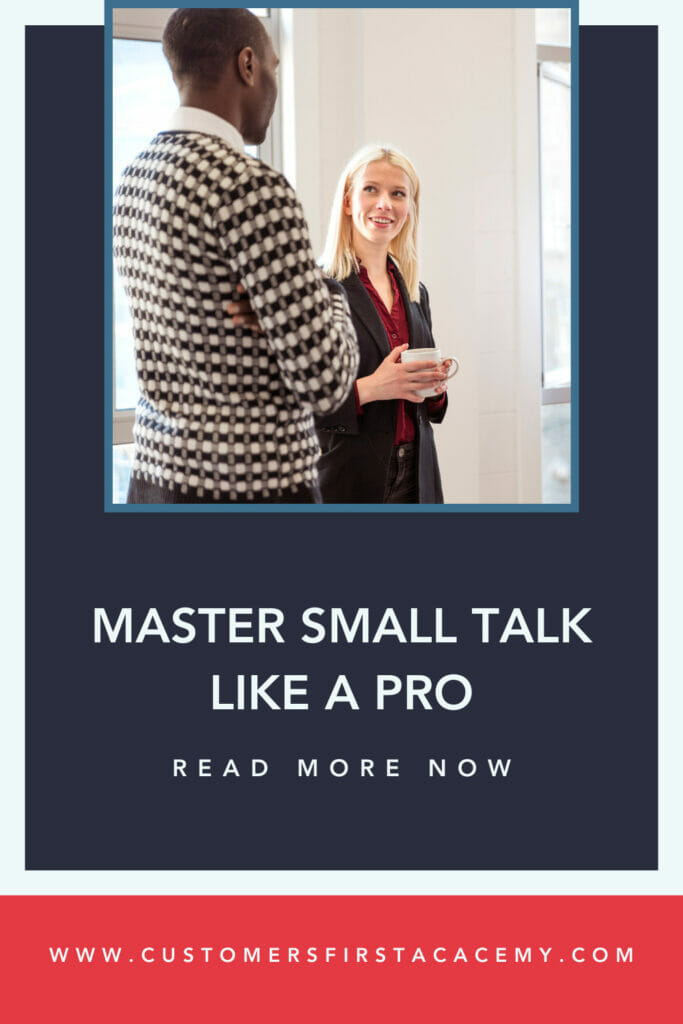Most salespeople and marketing professionals will agree that how you start a conversation makes all the difference in how you close a sale.
Small talk can be scary – especially when you’re not good at it! But how well you handle small talk is an important part of your job.
If this is not something that comes naturally to you, keep reading for my 10 tips on how to master small talk when interacting with clients!

Learn how to master small talk to connect with clients
1. Start with open-ended questions
An open-ended question requires more than just a yes or no answer. It’s the kind of question that requires an opinion. Try to avoid questions that can be answered with just a simple “yes” or “no.”
Open-ended questions encourage customers to keep the conversation going, which means you get more information on how your product or service might work for them.
Questions like “What do you think of your service so far?” or “What has been causing the problem with our product?” will motivate the customer to talk. And because it’s open-ended, they’re more likely to give you valuable information that leads to a sale.
Looking for more examples of probing questions? This audio tutorial covers 20+ probing questions you can ask your customers. Check it out!
2. Show genuine interest in their answer
Make sure to listen actively and show genuine interest by leaning forward and expressing how much you care about what the customers have to say.
This could be as simple as a positive head nod or a smile. Avoid interrupting and wait until they finish talking instead of cutting them off right away with another question. This will make them feel like you value what they have to say and make them more likely to share.
3. Ask for clarifying information
Open-ended questions encourage people to talk, but how do we get them started? This is where asking for clarifying information comes in.
For example: “Could you please explain how that occurred?” or “Could you give me an example of what happens when you do this?” Here you are getting them to describe how something works in more detail, allowing for a deeper insight into the issue.
4. Listen for keywords
Listen closely for specific words that tell you how the customer feels about something. These words could be very telling and show how interested they may be in what is being pitched so far.
If for example, they say something like: “Well, I haven’t talked with my manager yet” It might be a clue that they need to talk things over with someone else before committing.
Look for words like “definitely,” “never,” or “absolutely,” which are strong words that may indicate how confident the person is about your interaction.
5. Find things in common
The next step is to find common ground with the customer. This doesn’t necessarily mean you have to be similar, but it can be as simple as having a mutual acquaintance or talking about how the customer has traveled somewhere before.
Once this connection has been made, they will be more comfortable and open to speaking with you about what matters most to them.
Listen to our audio tutorial to learn how to use small talk in customer service!
6. Ask how your product fits into their lives
Another way that you can start conversations is by asking how they plan on using what you’re selling for their lives or business. You could ask something like: “Where do you see (insert product) fitting in down the road?”
This makes customers think about how valuable this tool would be for them, leading to how much they would be willing to pay for it.
7. Make it clear how you can help them
Before ending the conversation, make sure that you can express how what you are offering will benefit their lives or business in some way. This can be done through your features and benefits pitch, but it’s important that the customer feels how relevant these are to them.
They may not see how this tool could fit into their everyday routines right away, so give some examples of how it has helped others like them. If you have a case study or testimonial from someone who shares similar values or experiences as the client, this is a great place to draw on for inspiration.

Mastering small talk takes practice and patience
If things aren’t going how you had planned or your client is slower than you like them to be, remember: this is how you learn how people communicate and how people like to do things.
Keep your interactions open-ended, and remember that small talk is a great way for both parties to get comfortable with one another.
Remember to breathe! It’s okay to take a minute or two before diving into business matters. It takes time to build rapport and trust, but once you learn how to master small talk like a pro, it can lead to more business over time!
